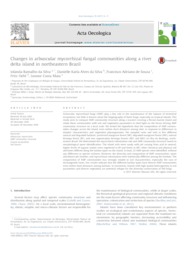Changes in arbuscular mycorrhizal fungal communities along a river delta island in northeastern Brazil.
Changes in arbuscular mycorrhizal fungal communities along a river delta island in northeastern Brazil.
Author(s): SILVA, I. R. da; SILVA, D. K. A. da; SOUZA, F. A. de; OEHLD, F; MAIA, L. C.
Summary: Arbuscular mycorrhizal fungi (AMF) play a key role in the maintenance of the balance of terrestrial ecosystems, but little is known about the biogeography of these fungi, especially on tropical islands. This study aims to compare AMF community structure along a transect crossing a fluvial-marine island and relate these communities with soil and vegetation parameters to shed light on the forces driving AMF community structure on a local scale. We tested the hypothesis that the composition of AMF communities changes across the island, even within short distances among sites, in response to differences in edaphic characteristics and vegetation physiognomies. We sampled roots and soils in five different natural and degraded habitats: preserved mangrove forest (MF), degraded mangrove forest (MD), natural Restinga forest (RF), and two regeneration Restinga forests (RR1 and RR2) on Ilha da Restinga, northeastern Brazil. We determined the mycorrhizal colonization rate and AMF community structure based on morphological spore identification. The island soils were sandy with pH varying from acid to neutral; higher levels of organic matter were registered in RF and lower in MF; other chemical and physical soil attributes differed along the habitat types on the island. In total, 22 AMF species were identified, without any difference in species richness. However, the diversity and composition of AMF communities, spore abundance per families, and mycorrhizal colonization were statistically different among the habitats. The composition of AMF communities was strongly related to soil characteristics, especially the sum of exchangeable bases. Our results indicate that the different habitat types have diverse AMF communities even within short distances among habitats. In conclusion, islands with high spatial heterogeneity in soil parameters and diverse vegetation are potential refuges for the diversity conservation of AM fungi.
Publication year: 2017
Types of publication: Journal article
Unit: Embrapa Maize & Sorghum
Keywords: Micorriza
Observation
Some of Embrapa's publications are published as ePub files. To read them, use or download one of the following free software options to your computer or mobile device. Android: Google Play Books; IOS: iBooks; Windows and Linux: Calibre.
Access other publications
Access the Agricultural Research Database (BDPA) to consult Embrapa's full library collection and records.
Visit Embrapa Bookstore to purchase books and other publications sold by Embrapa.

